Alienware's M17x R3: An Antidote to Clevo
by Dustin Sklavos on June 20, 2011 9:06 AM ESTHeat, Noise, and Battery Life
Examining these metrics is where you'll find the major differences in the Alienware M17x R3's internal design as compared to other gaming notebooks available. The 90Wh battery included is copious on its own, but the switchable graphics and smart cooling design (there are two intakes on the bottom and two exhausts just behind them) allow the M17x R3 to run cool, quiet, and long.

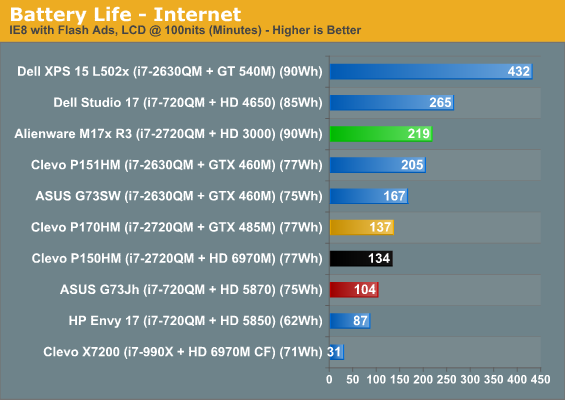

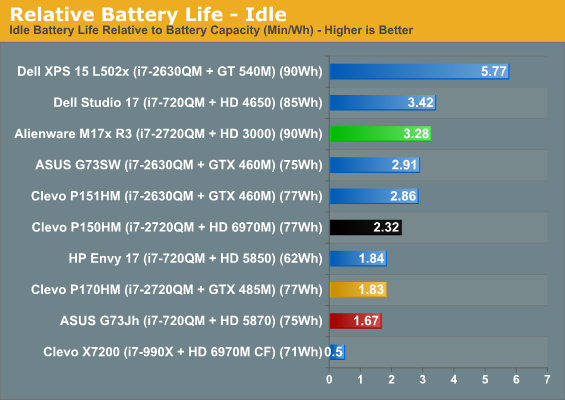
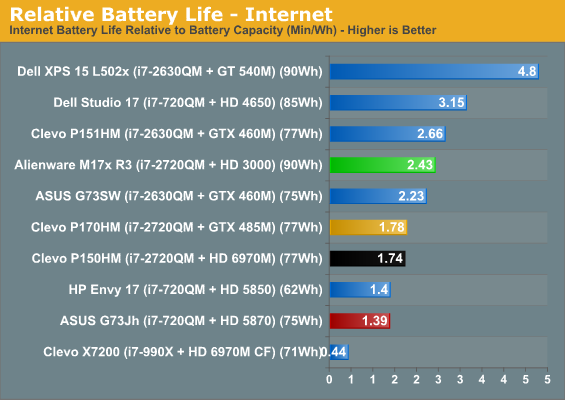
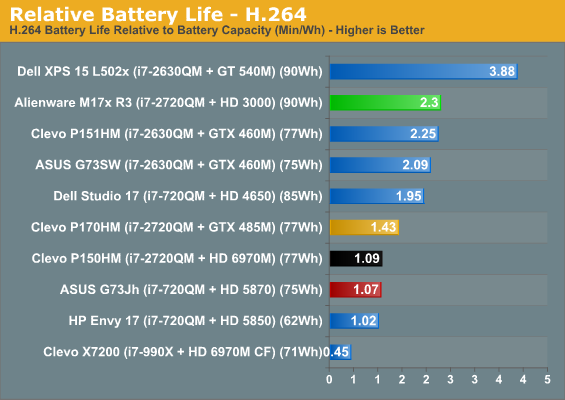
Despite offering a switchable graphics solution, the M17x R3 still can't keep up with the Dell XPS 15 and its Optimus-enabled GeForce GT 540M. That in mind, it's basically untouchable compared to the other gaming notebooks. Only the Clevo P151HM is able to come close, and that's with a weaker GPU and a smaller screen.
Where noise and thermals are concerned, the M17x R3 is as close to a model citizen as you can find when it comes to high-powered gaming notebooks. Only the ASUS G73 series really compares in terms of the low noise levels when the system is under load. The fan is definitely audible, but it's a low hum and nowhere near the hairdryers that many of the Clevo units can be when they're stressed (the X7200 is particularly nasty that way.)

With the hard disks in RAID 0, it's next to impossible to get thermal readings from those. What we're left with are a GPU and CPU that run admirably cool. The CPU is roughly where one expects a Sandy Bridge quad core to run in a notebook, but the GPU's thermals are fantastic. 79C may be hot by most standards, but for a top-of-the-line mobile GPU it's remarkably frosty.
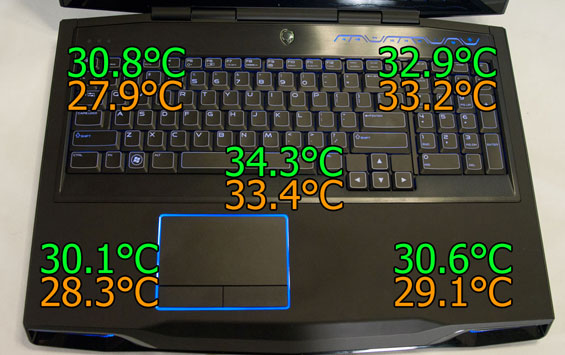

I have a friend of mine that tends to run his gaming notebook on his lap or on whatever surface is available. For the most part that works out (although it makes me more than a little nervous), but with the M17x R3 the basic advice is: don't. Ignoring the fact that the notebook is nearly ten pounds on its own, the bottom is where the intakes are, and it gets hot. That particularly nasty hot spot in the center is the personalized nameplate, which can become downright painful to touch.
The interior surfaces are far more accommodating though, with precious little in the way of hot spots. Your hands aren't liable to sweat while using the M17x R3, so as long as you're using the notebook the way it's intended (on a flat surface) you're probably going to be perfectly fine. I also appreciate that the notebook vents heat out of the back instead of either side, thus avoiding cooking your mousing hand.










84 Comments
View All Comments
Brad4 - Monday, June 20, 2011 - link
In the above message I intended to complain about 16x9 screen resolutions. Unfortunately, if someone wants a really nice laptop with a 16x10 resolution, the macbook pro is the only option. I will probably purchase the 17" mbp and install win7.Uritziel - Monday, June 20, 2011 - link
So for that 1080 -> 1200 small jump into the less common format, you're willing to live with the greatly reduced GPU and halved RAM, while paying separately for the Win 7 license? Those extra pixels must mean a lot to you. Too bad they'll drag the 6750M down even further...Brad4 - Monday, June 20, 2011 - link
That is correct. Unfortunately, it is the only option I'm left with.kmmatney - Tuesday, June 21, 2011 - link
Me too. It's not just a change of 1200 pixels - its a general reduction of the entire screen size. it feels like I'm looking through a slit with a 16x9 laptop. I'm not sure I want a MBP, but there's not too many other options out there now.I run a lot of VMs, and really need the vertical space.
cjl - Wednesday, June 22, 2011 - link
Why not just get a nice external monitor for use most of the time? That gives you even more space and resolution (potentially) than the MBP, while retaining the performance advantage of the Alienware.Uritziel - Tuesday, June 21, 2011 - link
I just figured, as a DTR, you could live w/ the 16:9 for the built-in monitor and just get a nice, external, 16:10, giant, productivity monitor. But, if that's not an option for your use case, I guess you're kinda stuck :\Spazweasel - Monday, June 20, 2011 - link
People who attach their self-worth and identity to what hardware they buy have no worth or importance of their own. Without the object of their hatred or the brand they've decided to ride the coattails of, they dry up and blow away.It's just hardware, dumbasses. The logo on it has no virtue or evil, no matter what that logo is. If it's evil you want, how about Dell's deliberate campaign of lies to cover up the extreme failure rate of their Optimus computers? Where's the outrage over that? Oh yeah, this isn't about truth. It's about shoring up a shattered self-esteem which actually deserves to be shattered. Haters gonna hate, and that's what makes them inferior.
Impotence + income jealousy + never having done anything to be proud of = logo hater.
k1ckass - Monday, June 20, 2011 - link
I think you mean Optiplex, Optimus is an Nvidia technology...RoninX - Monday, June 20, 2011 - link
I'm always impressed by the thoroughness of the Anandtech reviews compared to those of other popular tech blogs, and the M17x looks very nice to me (though I'd probably go with a smaller screen).One thing I would like to see in reviews of gaming/high-end laptops is an estimate of battery life while gaming. I know a lot of people use these as desktop replacements, but I already have a high-end gaming rig for home (i7-2600k + GTX570 + SSDs, etc.). However, I do a lot of traveling for business, and the only reason I would buy a gaming laptop is for playing games while waiting for flights (on battery) as well as at the hotel (on AC). This can turn "OMG, not another delay!" to "Oh well, back to gaming."
I recently purchased a Sandy Bridge Dell XPS 15 L502x, so I'm not in the market right now, but I like to keep up with what's coming down the pike. While some people would say that it's impossible to play high-end games for any significant time on battery power, that's not true. I get around 90 minutes of gaming on my XPS 15, and I carry a spare battery, so that gives me up to 3 hours, which is usually enough to deal with layovers as well as airport delays.
So, even though battery gaming time may be limited on any high-end laptop, the difference between, say, 90 minutes (one spare battery), 60 minutes (two spare batteries), and 30 minutes (five (!) spare batteries) can be significant. I would find this information very useful, and I'm guessing that others would as well.
Thanks...
Dustin Sklavos - Tuesday, June 21, 2011 - link
Your request isn't unreasonable and I know Jarred's dabbled in pulling those kinds of numbers. The problem I've seen is that sometimes notebooks running on the battery, regardless of whatever the power setting is, don't perform quite as fast as they would if they were plugged into the wall. So you wind up having to add a second metric: you're testing gaming running time on the battery, and you're testing performance on the battery.Honestly I think anyone wanting to game while on battery power would be best served just buying a Llano-based notebook. Is it going to be as fast as a Sandy Bridge-based one? No, but it's going to last a heck of a lot longer. Jarred ran the Llano test unit through a loop of 3DMark06 to see how long it would run gaming, and he got nearly three hours of running time.